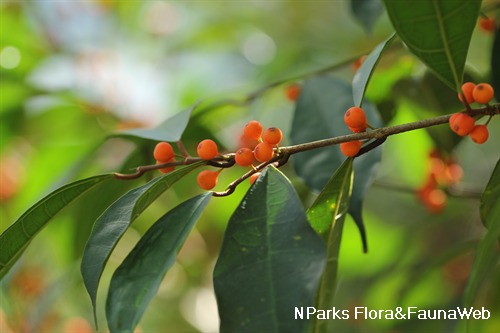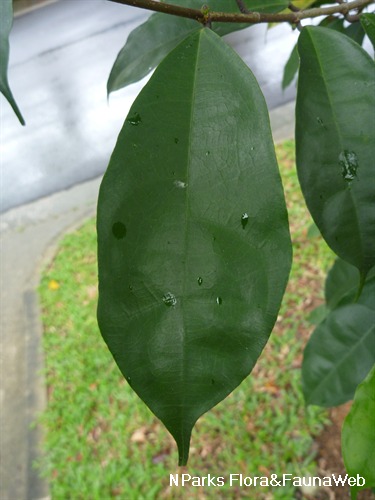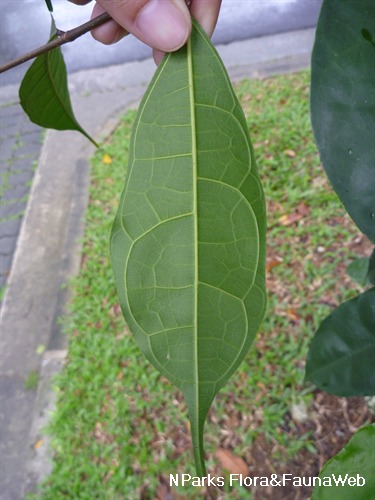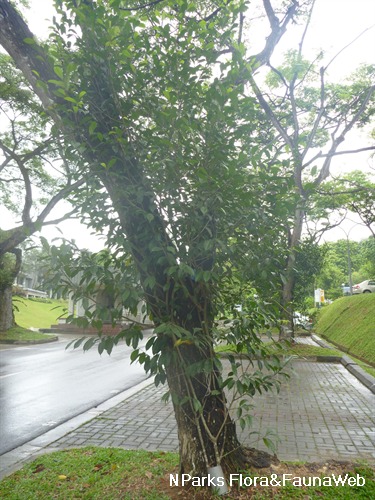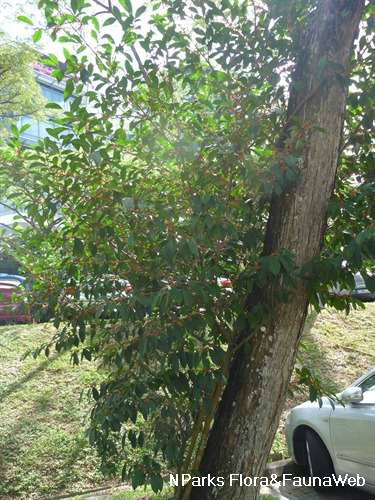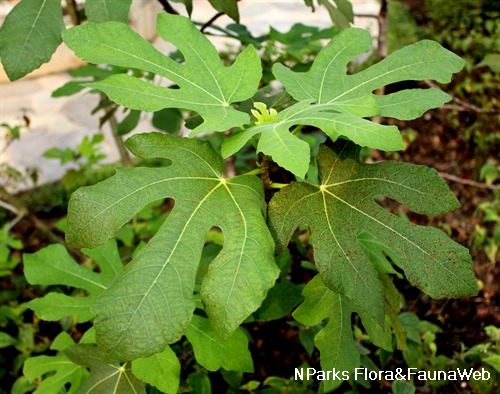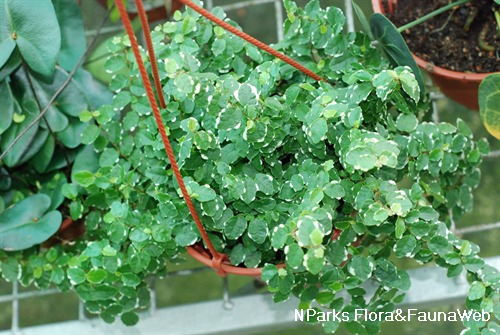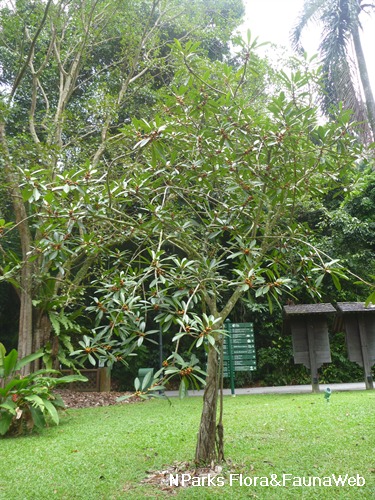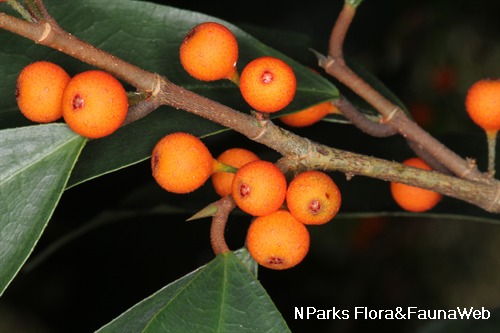
Back
Ficus heteropleura Blume
| Family Name: | Moraceae |
| Synonyms: | Ficus urophylla Wall. |
| Common Name: | Sandy-Leafed Fig |
Name
Classifications and Characteristics
| Plant Division | Angiosperms (Flowering Seed Plants) (Dicotyledon) |
|---|---|
| Plant Growth Form | Tree (Small (6m-15m)), Shrub |
| Lifespan (in Singapore) | Perennial |
| Mode of Nutrition | Autotrophic |
| Plant Shape | Irregular |
| Maximum Height | 13 m |
Biogeography
| Native Distribution | Northeast India, Bhutan, Hainan, and Southeast Asia (including Singapore). |
|---|---|
| Native Habitat | Terrestrial (Primary Rainforest, Mountain, Secondary Rainforest, Monsoon Forest, Freshwater Swamp Forest) |
| Preferred Climate Zone | Tropical |
| Local Conservation Status | Native to Singapore (Least Concern (LC)) |
Description and Ethnobotany
| Growth Form | It is a latex-containing, epiphytic shrub or small tree up to 13 m tall. |
|---|---|
| Foliage | Its alternate, stalked leaves have stiff leathery leaf blades that are 2.5–45 by 1–18 cm, with prominent, raised lateral veins below and that loop to rejoin the leaf margins. The texture on the underside of the leaf is rough, somewhat like sandpaper, hence giving its common name. |
| Flowers | It is dioecious plant, with staminate (male) or pistillate (female) flowers in separate plants. The flowers are borne in a specialised structure known as a syconium (fig) |
| Fruit | Its syconia (figs) are round, 1–2.5 cm wide, and ripen from bright orange to fire-cracker red. |
| Habitat | It grows in lowland to lower montane forests, up to 1,800 m altitude. In Singapore, it is often found growing out of fences, from cracks in roofs and walls, and as an epiphyte from urban trees. |
| Associated Fauna | Its flowers are pollinated by fig wasps, and its ripe syconia are eaten by birds. It is also the food plant for caterpillars of the butterfly, the striped blue crow (Euploea mulciber mulciber). |
| Cultivation | It can be propagated by seed, stem cutting or air-layering. |
| Etymology | Latin Ficus, the commercial edible fig (Ficus carica); Greek hetero, differing, Greek pleura, ribs of the veins, referring to varying patterns of the veins on the underside of the leaves. |
Landscaping Features
| Landscaping | Its brilliant orange, ripe figs are attractive. The rough underside of the leaves are also diagnostic of this species, hence its common name. It is suitable for gardens, parks and roadsides. Plants can be trained into hedges, standards or to climb trees or walls. |
|---|---|
| Desirable Plant Features | Ornamental Fruits |
| Landscape Uses | General, Suitable for Roadsides, Parks & Gardens, Small Gardens, Hedge / Screening, Reforestation |
| Thematic Landscaping | Naturalistic Garden, Butterfly Garden, Bird & Wildlife Garden |
Fauna, Pollination and Dispersal
| Fauna Pollination Dispersal Associated Fauna | Bird-Attracting (Fruits), Butterfly Host Plant (Leaves) |
|---|---|
| Pollination Method(s) | Biotic (Fauna) (Insects (Ant, Beetle, Fly, Thrip, Wasp)) |
| Seed or Spore Dispersal | Biotic (Fauna) |
Plant Care and Propagation
| Light Preference | Full Sun, Semi-Shade |
|---|---|
| Water Preference | Moderate Water |
| Plant Growth Rate | Moderate |
| Rootzone Tolerance | Moist Soils, Well-Drained Soils, Fertile Loamy Soils |
| Propagation Method | Seed, Stem Cutting |
Foliar
| Foliage Retention | Evergreen |
|---|---|
| Mature Foliage Colour(s) | Green |
| Mature Foliage Texture(s) | Leathery, Rough |
| Foliar Type | Simple / Unifoliate |
| Foliar Arrangement Along Stem | Alternate |
| Foliar Attachment to Stem | Petiolate |
| Foliar Shape(s) | Non-Palm Foliage (Elliptical) |
| Foliar Venation | Pinnate / Net |
| Foliar Margin | Entire |
Non - Foliar and Storage
| Trunk Type (Non Palm) | Woody |
|---|---|
| Stem Type & Modification | Woody |
| Root Type | Underground, Aboveground (Aerial Root) |
Floral (Angiosperm)
| Flower & Plant Sexuality | Unisexual Flowers , Dioecious |
| Flower Grouping | Cluster / Inflorescence |
|---|
| Inflorescence Type | Syconium |
Fruit, Seed and Spore
| Mature Fruit Colour(s) | Orange, Red |
|---|---|
| Fruit Classification | Multiple Fruit |
| Fruit Type | Fleshy Fruit , Accessory / False Fruit (Pseudocarp) |
References
| References | Tan, P.Y., R.T. Corlett and H.T.W. Tan (Editors). 2010. A Field Guide to the Native Garden @ HortPark: an Urban Oasis of the Native Flora and Fauna of Singapore. Singapore: Centre for Urban Greenery and Ecology (National Parks Board) and National University of Singapore. 124pp |
|---|
Image Repository
Others
| Master ID | 29874 |
|---|---|
| Species ID | 4183 |
| Flora Disclaimer | The information in this website has been compiled from reliable sources, such as reference works on medicinal plants. It is not a substitute for medical advice or treatment and NParks does not purport to provide any medical advice. Readers should always consult his/her physician before using or consuming a plant for medicinal purposes. |

